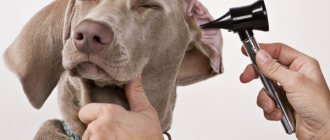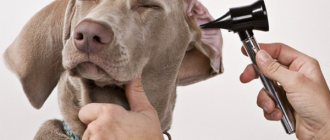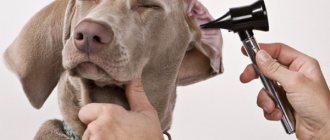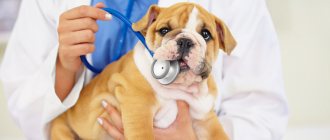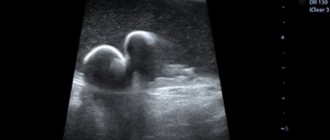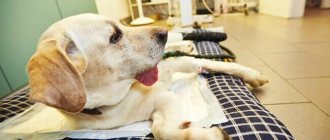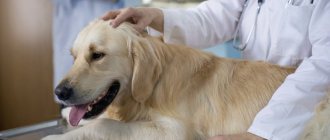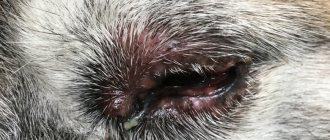Signs of otitis in a dog are an alarm bell, suggesting a response from the owner. The neglected process threatens not only hearing loss, but also infection of the brain. To avoid death, veterinarians recommend being vigilant and seeking help in a timely manner. Owners of high-risk animals should exercise special caution.
What is otitis media in dogs?
The disease is not difficult to diagnose yourself. It is much more difficult to determine the exact type of otitis in a dog and understand what to do to eliminate it.
What is otitis media
This disease is an inflammation of the dog's ear. The inflammatory process is often accompanied by the presence of infection, but is not always explained by it. Sometimes concomitant infectious diseases turn out to be secondary and occur as a result of weakened immunity.
How does the disease manifest in dogs?
Sick animals exhibit behavioral and physiological changes. They constantly shake their heads, run in circles, scratch themselves and become restless. As the pathology develops, pain inside the ear increases. With bacterial infections, microbes infect the mucous membranes, leading to their swelling, the appearance of mucus and suppuration.
Signs of ear inflammation
Irritating itching and soreness change the pet's usual behavior. He whines when touched, refuses games and favorite food, rolls on the floor, and constantly scratches himself with his paws or on furniture. When moving, the dog walks with its head tilted to one side and periodically shakes it.
Frequent and intense scratching leads to peeling and the formation of bald patches. Otitis in a dog is replenished with new signs:
- increased local ear temperature;
- leakage of serous or purulent fluid from the ears;
- the appearance of a sharp sweetish or putrid odor from the ears;
- redness and swelling of the outer ear;
- inflammation of the submandibular lymph nodes;
- the appearance of pain when touching not only the outer, but also the inner side of the ear;
- the formation of crusts and scabs at the entrance to the auditory opening.
As the condition worsens, the symptoms are supplemented by strabismus, discharge of pus from the eyes, hearing impairment and disruption of the chewing process due to intense pain. If you notice signs and symptoms of otitis media in dogs, you should not delay treatment. The sooner help is provided to the victim, the greater the chance of preventing complications.
Auricular hematoma
Hematoma of the auricle, otherwise called otohematoma, is an accumulation of fluid between the cartilage and skin of the ear. A hematoma occurs due to rupture of blood and/or lymphatic vessels, as a result the ear greatly increases in size.
Symptoms:
- Thickening or swelling of the ear, its drooping, tilting the dog’s head to the side.
— The disease is often accompanied by itching, which can provoke scratching and further trauma to the ear.
Treatment:
1. Apply a pressure bandage for 5-6 days, then open and remove dead tissue.
2. Large wounds are stitched.
3. After the operation, the ears are wrapped around the head and a bandage is applied. For better healing, the bandage is applied with ointments Levomekol, Methyluracil, Solcoseryl.
============================================================================================================================================================================================
Factors provoking the disease
The likelihood of developing ear problems increases when certain factors are present. Most of them affect the performance of the immune system, which is responsible for fighting pathogenic microorganisms.
Main reasons
How and with what to treat otitis in a dog depends on its cause. The main provoking factors include:
- Atresia of the auditory canal
. Natural ventilation is disrupted due to the growth of folds and cartilage that block the inlet. This promotes the development of pathogenic microflora.
- Hormonal imbalances
. The disease develops as a complication against the background of pathologies of the thyroid gland, urinary system, as well as other important systems and organs.
- Infectious diseases
caused by bacteria, fungi and viruses.
- Allergy
. Under the influence of atopic dermatitis and food allergies, the production of earwax increases, which can lead to the formation of plugs.
- Improper feeding
. Sometimes the cause of irritation is excess sugar, which leads to the formation of “sweet” sulfur, which attracts bacteria.
- External parasites
. When a pet is infected with ear mites, it develops otodectosis.
- Injuries
. The ears can be damaged not only in fights, but also by a foreign body. Both sharp objects and ordinary grass pose a danger.
- Improper care
. Cleansing too infrequently is no less dangerous than cleansing too often. The latter disrupts the natural layer of sebum and wax that lubricates and cleans the ear canals.
- Neoplasms
. The appearance of tumors and papillomas leads to the same consequences as atresia.
- Fluid retention in the ear
. Water remaining after bathing attracts pathogenic microorganisms.
Due to their body structure, some breeds are at risk. To prevent the disease, they will have to be regularly taken to the veterinarian for preventive purposes.
What breeds are at risk?
The risk group includes long-eared pets, dogs with folded skin, excessive accumulation of hair inside the ears and a predisposition to allergies. These include:
- toy terriers;
- dachshunds;
- collie;
- bulldogs;
- spaniels;
- chow-chow;
- setters;
- Shar-Pei;
- basset hounds;
- huskies and other breeds with similar problems.
In such animals, natural thermoregulation and ventilation are disrupted from birth. This fact must be taken into account when purchasing a puppy, since you will have to devote a lot of time to your pet’s hygiene.
Etiology (causes of occurrence) of otitis media
Primary reasons:
- allergy (hypersensitivity, atopy)
- parasitic diseases (otodectosis, notoedrosis, cheyletiellosis, demodicosis)
- autoimmune processes and diseases (pemphigus foliaceus, discoid lupus erythematosus)
- some viral diseases (otitis media associated with canine distemper virus has been described)
- foreign objects (especially small cereal seeds)
- neoplasms (eg, ceruminous gland tumors)
- endocrinopathies
Secondary causes:
- bacterial inflammation
- fungal diseases (Malassezia dermatitis, candidiasis)
Predisposing factors:
- the structure of the ear canal (drooping ears, congenital stenoses (Shar Pei), an abundance of hair in the external auditory canal), causing impaired ventilation of the ear canal
- high humidity, warm season
- swimming, diving, especially in polluted waters
mechanical damage to the external auditory canal (due to improper ear cleaning)
Types of otitis media in dogs
The doctor determines how to treat otitis in a dog only after specifying its type. During diagnosis, 5 classifications are taken into account, determining the location and cause of the lesion, the form of the disease, the nature of the discharge and the sequence of manifestation.
By localization
The ear consists of the auricle, the tympanic cavity and the membranous labyrinth. Depending on the location of the disease, it can be:
- external, that is, covering the area up to the eardrum;
- medium, when the inflammatory process begins in structures located further than the eardrum;
- internal, when inflammation affects the membranous labyrinth.
The external appearance is less dangerous, since the infection does not penetrate the membrane. In other cases, there is a negative effect on the nervous system, which can lead to brain damage.
By pathogen
Due to infection, veterinarians distinguish 5 types of pathology. These include:
- Parasitic
. The appearance of parasites is accompanied by itching in both ears or the formation of black-brown grains.
- Traumatic
. Unlike ear mites, injuries are only bothersome on the injured side.
- Verrucous
. Associated with the formation of warts blocking the ear canal.
- Allergic
. An allergic reaction is difficult to self-diagnose, so contacting a veterinarian is the only reasonable option.
- Infectious
. Includes viral, fungal and bacterial otitis media in dogs. Accompanied by an increase in temperature and copious discharge of pus, which appears when pathogenic microorganisms multiply.
Some fungi are present in the body in a dormant form and wake up only due to decreased immunity. Often the fungal form occurs together with the bacterial one, as a weakened body becomes more vulnerable.
According to the form of flow
Depending on the intensity and duration, the pathology can be acute or chronic. The first type is characterized by vivid symptoms, which make it possible to detect inflammation at an early stage. It is easier to treat, but can develop into a chronic form. In this case, the symptoms are smoothed out, but may worsen with relapses. This clinical picture is typical for allergies. The chronic form is difficult to treat, so therapy is based on preventing new attacks and relieving acute symptoms.
By type of discharge
Depending on the type of discharge, otitis in dogs can be purulent and exudative. In the first case, the main symptom is yellow-green discharge with an unpleasant odor, in the second - abundant sulfur discharge.
By origin
The disease can be primary or secondary. In the second case, it occurs against the background of viral infections, sinusitis, pharyngitis and other diseases of the upper respiratory tract.
Separately, veterinarians distinguish an idiopathic variety. This means that there are no exact causes that led to the disease. Despite the presence of characteristic symptoms, diagnosis does not allow tracking the factor that provoked the inflammation.
Diagnosis of otitis media
Basic diagnostic methods
- inspection
- otoscopy (visual examination of the vertical auditory canal using a special device - an otoscope)
- cytological examination is an examination of a specially stained smear from the external auditory canal, which allows one to assess which cells and in what quantity are present in the exudate, as well as identify parasites, bacteria, and opportunistic fungi. This study may be required every 2-3 weeks to monitor treatment and response to therapy.
Additional diagnostic methods
- bacteriological examination (culture, determines the sensitivity of flora to antibiotics)
- endoscopic examination of the deep structures of the auditory canal (horizontal part) and eardrum (myringoscopy) - the study is carried out under general anesthesia.
- radiography of the tympanic cavity - as a rule, for a high-quality image, complete immobility of the animal and symmetrical positioning are necessary, which is only possible under sedation.
- MRI (under general anesthesia).
Complications and consequences
The main danger of the disease is the possible rupture or dissolution of the eardrum due to the abundance of purulent discharge. Penetration of pus into the inner ear is fraught with hearing loss or death from purulent meningitis. Surgical operations on brain tissue associated with the ears are no less dangerous. In an attempt to save the animal, the surgeon may touch the nerve endings responsible for motor function. After this, the pet will forever remain disabled.
Structure of the ear and vestibular apparatus
The auditory and vestibular apparatus are a single system that consists of the outer, middle and inner ear.
Outer ear.
It is represented by the auricle and the ear canal, which ends with the eardrum.
Middle ear.
It is a round chamber with a system of bones - the malleus, the incus and the stirrup; these bones transmit sound vibrations from the eardrum to the inner ear. The chamber itself plays the role of a resonator, which amplifies the vibrations. From it comes the Uvstachian tube, a canal that connects the middle ear to the nasopharynx.
Inner ear
Located entirely in the bone, it consists of the cochlea and semicircular tubules. The first part is a chamber where sound vibrations are processed into a nerve impulse. The auditory nerve approaches the cochlea. The second part - the semicircular canals - is the vestibular apparatus. All sections are filled with liquid.
Diagnosis of the disease and its type
It is very difficult to determine otitis in a dog based on photos of clinical symptoms. Instead of self-diagnosis, veterinarians recommend seeking help at the first suspicion.
After taking a history and examining the four-legged patient, the veterinarian:
- examines tests of urine, blood, scrapings and smears that determine the type of pathogen;
- takes an x-ray to assess the size and severity of the formations;
- performs MRI and CT scans that monitor the depth of the lesion.
At the end of all these procedures, the doctor makes a diagnosis and decides whether it is permissible to treat otitis in a dog at home. If the lesion is superficial and there are no complications, all care is carried out at home.
Breeds particularly susceptible to otitis media
Breeds with a specific structure of the auricle or with long hair that grows in the ears are prone to the appearance and development of otitis.
Thick guard hairs obscure the canal, interfere with natural ventilation, and promote the accumulation of sulfur and the proliferation of bacteria in it. The risk group includes all pets with long hair: Lapdogs, Pekingese, Yorkshire terriers, Setters, long-haired Toy terriers, etc.
Similar problems arise in animals with long floppy ears: Spaniels, Setters, Bassets, Poodles. In addition, the self-cleaning mechanisms are hampered by the abundant skin folds around the ears of Bulldogs, various breeds of Mastiffs, and Shar-Peis.
A separate group predisposed to the disease are dogs with long erect ears: German Shepherds, Corgis, Staffies, Giant Schnauzers. They turn their ears to the wind, thereby catching drafts and chilling the hearing organs.
Any breed can be affected by the disease. It is important to monitor the hygiene of the ear cavities, checking it for dirt, strange discharge and stuck objects.
How dangerous is the disease?
In general, with timely and competent treatment, otitis media will not be a dangerous disease. However, in the opposite case, inflammation develops into chronic inflammation and attracts unpleasant problems. The first terrible complication is hearing loss (complete or partial).
First of all, the inner ear, which is directly connected to the brain, is at risk. If the infection is advanced, the pet may even die. In addition, when bacterial formations develop, heart complications arise.
To avoid consequences, treatment should be carried out under the supervision of a veterinarian. Further examination of the pet should be thorough; the dog should be shown to a doctor twice a year, and its auditory organs should be examined frequently.
Help at home
Before going to the veterinarian, owners try to improve the pet’s condition on their own. Most often, this leads to negative consequences, since some obvious actions are prohibited.
What to do before visiting the veterinarian
Before visiting a veterinary clinic, the owner can independently examine the sore ears without foreign objects. Wounds found on the outside are treated with brilliant green or peroxide.
You can put Otipax drops into your dog's ears. They relieve pain, relieve itching and soften formations inside the ears. If pus or excessive discharge appears, accompanied by squelching inside the ear, use a mixture of boric acid and streptocide (5:1). Hyperthermia is eliminated with Analgin. These actions are carried out only after a telephone consultation with a veterinarian.
What actions will harm
Avoid using medications to treat ear infections in your dog until you visit your veterinarian. If you have severe pain, fever or an abundance of pus, contact your doctor by phone and ask about the possibility of taking Otipax, Analgin or other medications.
Remember that only the external part is treated with alcohol-containing anesthetics. The peroxide inside the damaged ear will react noisily with the blood and scare the pet.
Don't try to clean your ears with cotton swabs. Any wrong movement can damage the eardrum. Use cotton pads.
Warming up is strictly prohibited. A humid and warm environment will worsen inflammation due to the growth of pathogenic microorganisms.
Eczema
The cause of irritation in the form of eczema occurs due to pollen entering the ear. Water, chemicals, sulfur accumulation. Sometimes the cause is parasitic insect bites.
Symptoms:
— Itching begins in the ear, redness appears.
— The dog shakes its head and tries to scratch its ears. As a result of scratching, the eczema blisters burst and become infected. Secondary inflammation of the skin may develop against the background of eczema.
Treatment:
1. Instillation of drugs Ottinum, Ottipax into the ears.
2. Drops can be supplemented with painkillers (Diphenhydramine, Analgin).
3. The skin inside the ear is wiped with disinfectants - Rivanol, Hydrogen Peroxide, Boric Acid.
4. If there is severe irritation or swelling, use Geocorton and Hydrocortisone ointments.
============================================================================================================================================================================================
Carrying out treatment
After diagnosis, the goals of therapy are reduced to destroying the pathogen, relieving symptoms and eliminating any complications that have arisen. Most cases are treated with medication. The four-legged patient is prescribed medications and sent home, where the owner carries out hygienic treatment of the affected areas every day.
Inpatient treatment and surgical intervention are carried out for purulent forms, detection of a tumor or foreign object, as well as spontaneous overgrowth of the ear canal. After eliminating the cause of the disease and normalizing the pet’s condition, the pet is sent for home treatment.
What medications will the doctor prescribe?
The verrucous and traumatic type of the disease is dealt with by the surgeon. To eliminate an allergic reaction, antihistamines are prescribed. For infectious otitis media in dogs, antibiotics are used. The body poisoned by parasites is restored with detoxification solutions and a course of immunomodulators.
Popular drugs include:
- antibiotics – Ceftriaxone, Amoxicillin;
- wound healing ointments – Levomekol, Sanatol, Safroderm;
- antiseptics – hydrogen peroxide 3%, Chlorhexidine 0.05%;
- detoxification solutions – Sirepar, Hemodez, Hydrolysin;
- hygiene lotions – Otifri, Otoklin, Epi-Otik;
- immunomodulators – Ascorutin, Imunofan, Gamavit;
- antifungal ear drops – Clotrimazole, Terbinafine, Nitrofungin;
- anti-inflammatory, analgesic and antipruritic ear drops - Otipax, Otinum;
- antimicrobial ear drops - Anandin, Tsipromed, Sofradex;
- antiparasitic ear drops – Bars, Dekta, Amitrazine.
All of the medications listed are prescribed individually. Do not use medications without the approval of your veterinarian.
Hygiene procedures
Antimicrobial and antifungal ear drops for otitis media for dogs should be slightly warmed in the palms of your hands before use. This increases their efficiency. After warming up, drop the product into the ears and gently massage the base of the ear.
Before using the preparations, do not forget to remove crusts and dirt with hygienic lotions or antiseptics applied to a cotton pad. Treat wounds and scratches daily with anti-inflammatory and wound-healing medications.
The duration of antibiotic therapy is 5-7 days and depends on the severity of the disease. If you feel better earlier, treatment does not stop.
Why you can’t use folk remedies
Herbal treatment is strictly unacceptable for allergies and is ineffective in other cases. Sometimes a veterinarian prescribes folk remedies with an antiseptic effect as part of complex therapy, but most often the choice falls in the direction of recognized antiseptics.

